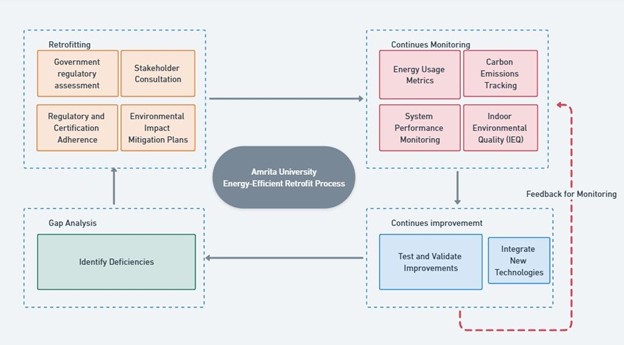Programs
- M. Tech. in Automotive Engineering -Postgraduate
- B. Tech. in Computer Science and Engineering (Quantum Computing) 4 Years -Undergraduate
Amrita’s Higher Energy Efficiency Buildings initiative represents a visionary approach to advancing sustainability, aligning seamlessly with the 2030 Sustainable Development Goals (SDGs). This ambitious initiative, rooted in the Chancellor’s unwavering commitment to fostering a greener, more frugal, and sustainable lifestyle, underscores Amrita University’s dedication to environmental stewardship and its role as a leader in sustainable development within the academic community.
A rigorous process is implemented to facilitate energy-efficient retrofitting, ensuring the upgraded building achieves a significantly higher level of energy efficiency. These practices align with the standards set by ASHRAE 90.1-2007 and the LEED certification models.

To achieve the goals outlined in this initiative, Amrita has implemented a comprehensive process designed to promote continuous improvement and ensure compliance with both national and international standards. This process encompasses a range of strategies and processes aimed at closing gaps in existing sustainability practices while leveraging cutting-edge advancements in global sustainability innovations. By integrating these innovations, the university ensures the adoption of proven best practices that enhance energy efficiency, reduce environmental impact, and align with broader sustainability objectives thereby achieving 32.4% of energy cost savings.
The initiative systematically evaluates current sustainability practices, identifying areas for enhancement and aligning them with global benchmarks. By fostering a culture of innovation, the university actively incorporates state-of-the-art technologies and methodologies, transforming its operations and infrastructure into a model of energy efficiency and environmental responsibility. This dynamic approach ensures that Amrita remains at the forefront of sustainable practices, creating a ripple effect of positive change within and beyond its campus.
Amrita’s commitment to excellence is further exemplified by its active participation in national and international certification programs, awards, and accreditations. These engagements not only validate the university’s efforts but also serve as a platform for benchmarking its progress against global leaders in sustainability. Through these recognitions, Amrita demonstrates its dedication to implementing best practices and achieving tangible outcomes that contribute to the realization of the UN SDGs.
The University has undertaken extensive in-house research to advance energy efficiency through collaborative efforts across multiple departments, including Electrical and Electronics Engineering, Civil Engineering, Chemical Engineering and Materials Science, and the School for Sustainable Futures. Dedicated PhD students are actively engaged in various projects, contributing to this endeavor. These research initiatives have played a pivotal role in informing critical design and procurement decisions, significantly improving the University’s energy efficiency while achieving substantial energy cost savings.
Transportation
Building Design




Energy Efficiency Plan




Energy Efficiency Plan

Energy Efficiency Plan

Energy Efficiency Plan


Energy Efficiency Plan
